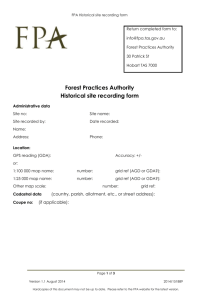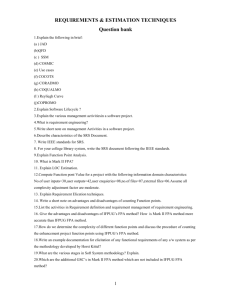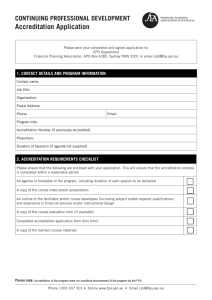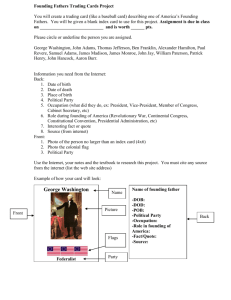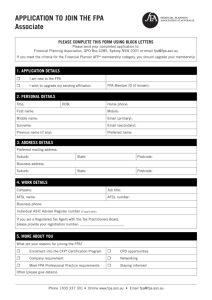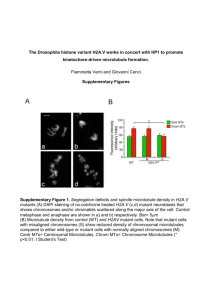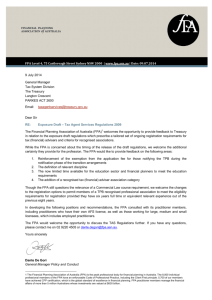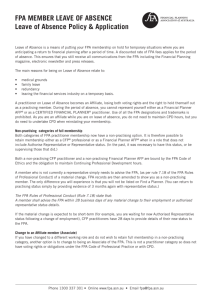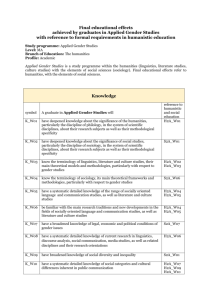guide to organising the founding meeting of a fire protection
advertisement
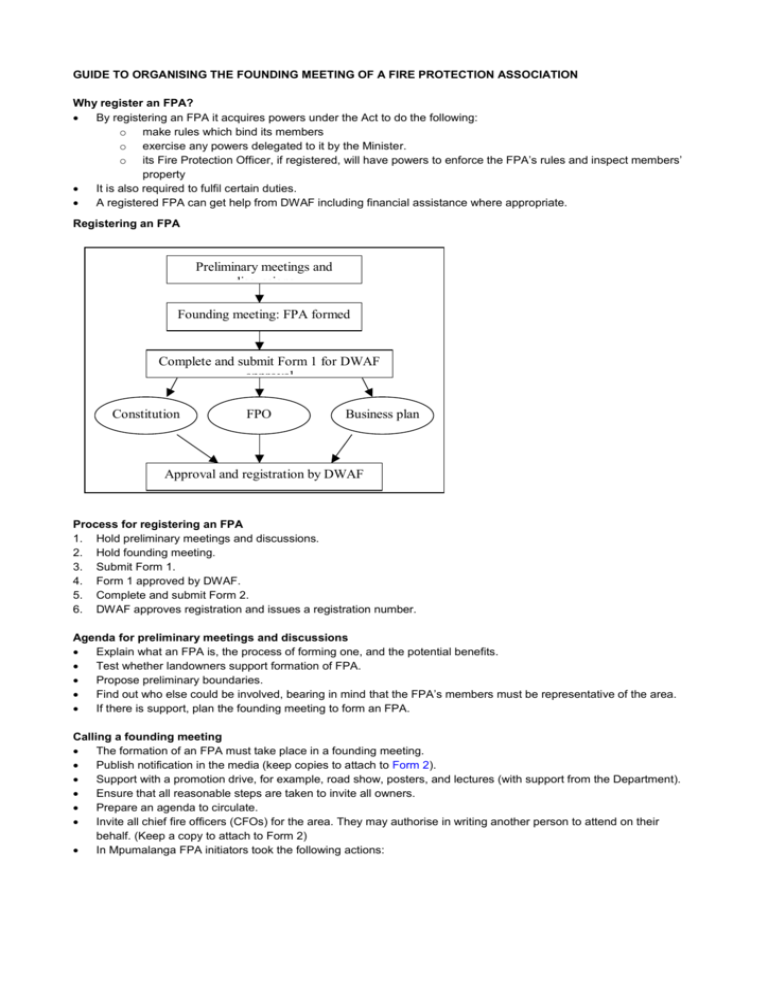
GUIDE TO ORGANISING THE FOUNDING MEETING OF A FIRE PROTECTION ASSOCIATION Why register an FPA? By registering an FPA it acquires powers under the Act to do the following: o make rules which bind its members o exercise any powers delegated to it by the Minister. o its Fire Protection Officer, if registered, will have powers to enforce the FPA’s rules and inspect members’ property It is also required to fulfil certain duties. A registered FPA can get help from DWAF including financial assistance where appropriate. Registering an FPA Preliminary meetings and discussions Founding meeting: FPA formed Complete and submit Form 1 for DWAF approval Constitution FPO Business plan Approval and registration by DWAF Process for registering an FPA 1. Hold preliminary meetings and discussions. 2. Hold founding meeting. 3. Submit Form 1. 4. Form 1 approved by DWAF. 5. Complete and submit Form 2. 6. DWAF approves registration and issues a registration number. Agenda for preliminary meetings and discussions Explain what an FPA is, the process of forming one, and the potential benefits. Test whether landowners support formation of FPA. Propose preliminary boundaries. Find out who else could be involved, bearing in mind that the FPA’s members must be representative of the area. If there is support, plan the founding meeting to form an FPA. Calling a founding meeting The formation of an FPA must take place in a founding meeting. Publish notification in the media (keep copies to attach to Form 2). Support with a promotion drive, for example, road show, posters, and lectures (with support from the Department). Ensure that all reasonable steps are taken to invite all owners. Prepare an agenda to circulate. Invite all chief fire officers (CFOs) for the area. They may authorise in writing another person to attend on their behalf. (Keep a copy to attach to Form 2) In Mpumalanga FPA initiators took the following actions: o o o o a DWAF extension officer did a road show of 24 presentations to tribal authorities, transitional local councils, farmers’ associations and city and town councils. 100 posters were put up. a notice was published in The Lowvelder. A fax was sent to all the Nelspruit Fire Fighting Association, as well as Eskom, the Fire Brigade, The Rural Action Committee (an NGO), Spoornet, the Institute for Tropical and Subtropical Crops, Agri-SA and the Mpumalanga Parks Board. Purpose of a founding meeting To vote on establishing an FPA. To give the FPA a name. To confirm the FPA’s boundaries. To elect an Executive Committee. To nominate a Fire Protection Officer. To approve the process of applying for registration. Agenda of a founding meeting Elect a chairperson for the meeting. Explain the process and what the FPA is about. Allocate votes. Confirm support for establishing the FPA. Decide on a name. Confirm the proposed boundaries. Elect the Executive Committee. Assign tasks to the Executive Committee. Nominate the Fire Protection Officer. Get approval to prepare Form 1. Representation at the founding meeting Only owners as defined in the Act may vote. Owners who represent themselves personally at the founding meeting get one vote each. For example, Mr Smal, a game farm owner present at the meeting, gets one vote. Any owner or organisation who represents another owner or owners gets one vote per owner so represented. For example, Emanzini Farmers’ Union, which is representing 22 small scale farmers, gets 22 votes. A copy of the owner's written consent to be represented must be kept by the owner and the representative. Owners who are represented by another owner or an organisation, but who are present at the founding meeting, may not vote (because the other owner or organisation is already voting for them). Ms Mthimkulu, who is being represented by Emanzini Farmers’ Union, may attend the meeting but may not vote. She has already given the farmers’ union a mandate to vote on her behalf. Voting The elected chairperson must allocate votes as follows: o One vote for each owner representing him/ her/ itself. This includes State and municipal owners. o Where an owner represents another owner, the owner is allocated on vote for each owner so represented. o Where an organisation represents an owner, it is allocated one vote for each owner represented. An owner who is represented by an organisation has no individual vote. All owners or their representatives must come to the meeting with the authority to vote. The founding meeting must vote on whether an FPA should be set up. If it votes in favour, it must at least: o propose and vote on a name for the FPA o decide on the area of jurisdiction o elect its Executive Committee o nominate the FPO unless it does not have the means to do so. Minutes The minutes must record: o the number of votes for, against and abstaining o confirm the name, boundaries, Executive Committee and FPO's name o agreement to prepare Form 1. Attached to the minutes must be: o an attendance register with everyone's names and contact details on it o if applicable, a copy of the Chief Fire Officer's written authorisation for another person to attend on his or her behalf. Checklist of outputs from founding meeting An attendance register with everyone’s contact details and property names on it, including the names of the organisations or owners representing other owners. Where owners were represented by other owners or organisations, the register must specify who was represented and by whom. Contact details must include name, postal address, telephone numbers, cell phone numbers, fax numbers and email addresses. Where a Chief Fire Officer has authorised in writing another person to attend on his/her behalf, a copy of that written authorisation. A name for the FPA. An address for the FPA (if known). Minutes indicating: The number of votes for establishing the FPA. The number of votes against establishing the FPA. The number of abstentions. A confirmation of the proposed boundaries for the FPA. A list of Executive Committee members. The name of the nominated Fire Protection Officer. Agreement to prepare Form 1: Application for registration of a fire protection association Part 1.
